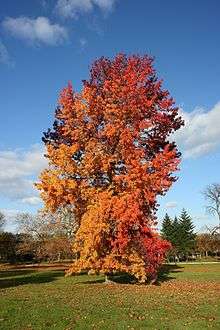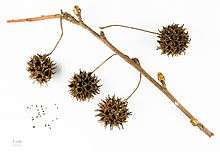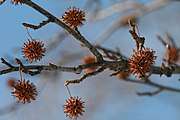Liquidambar
Liquidambar, commonly called sweetgum[1] (star gum in the UK),[2] gum,[1] redgum,[1] satin-walnut,[1] or American storax,[1] is the only genus in the flowering plant family Altingiaceae and has 15 species.[3] They were formerly often treated in Hamamelidaceae. They are decorative deciduous trees that are used in the wood industry and for ornamental purposes.
| Liquidambar | |
|---|---|
 | |
| Sweetgum (Liquidambar styraciflua) | |
| Scientific classification | |
| Kingdom: | Plantae |
| Clade: | Tracheophytes |
| Clade: | Angiosperms |
| Clade: | Eudicots |
| Order: | Saxifragales |
| Family: | Altingiaceae |
| Genus: | Liquidambar L. |
| Type species | |
| Liquidambar styraciflua L. | |
Etymology
Both the scientific and common names refer to the sweet resinous sap (liquid amber) exuded by the trunk when cut.
Species
Extant species
| Image | Scientific name | Common Name | Distribution |
|---|---|---|---|
.jpg) | Liquidambar acalycina | Chang's sweetgum | central & southern China |
_(21652161393).jpg) | Liquidambar formosana | Chinese sweetgum or Formosan sweetgum | central & southern China, southern Korea, northern Thailand, Taiwan, Laos, northern Vietnam |
 | Liquidambar orientalis | Oriental sweetgum or Turkish sweetgum | southwest Turkey, Greece: Rhodes |
.jpg) | Liquidambar styraciflua | American sweetgum | eastern North America from New York to Texas and also eastern Mexico to Honduras |
Fossils
- †Liquidambar changii - Miocene (Washington state, North America)
Description
They are all large, deciduous trees, 25–40 metres (82–131 ft) tall, with palmately 3- to 7-lobed leaves arranged spirally on the stems and length of 12.5 to 20 centimetres (4.9 to 7.9 in), having a pleasant aroma when crushed. Their leaves can be many colors such as bright red, Orange and yellow.[4] Mature bark is grayish and vertically grooved.[4] The flowers are small, produced in a dense globular inflorescence 1–2 centimetres (0.39–0.79 in) diameter, pendulous on a 3–7 centimetres (1.2–2.8 in) stem. The fruit is a woody multiple capsule 2–4 centimetres (0.79–1.57 in) in diameter (popularly called a "gumball"), containing numerous seeds and covered in numerous prickly, woody armatures, possibly to attach to fur of animals. The woody biomass is classified as hardwood.

In more northerly climates, sweetgum is among the last of trees to leaf out in the spring, and also among the last of trees to drop its leaves in the fall, turning multiple colors. Fall colors are most brilliant where autumn nights are chilly, but some cultivars color well in warm climates. Although a temperate species, at least one living Liquidambar tree survives in a hot and humid tropical city: Bangkok, Thailand.
Distribution
Species within this genus are widespread in China, Korea, Thailand, Taiwan, Laos, Vietnam, Turkey, Rhodes, North America and Mexico (down to Honduras). In cultivation they can be seen in warm temperate and subtropical climates around the world.
Fossil records
This genus is known in the fossil record from the Cretaceous to the Quaternary (age range: 99.7 to 0.781 million years ago).[5] The genus was much more widespread in the Tertiary, but has disappeared from Europe due to extensive glaciation in the north and the east-west oriented Alps and Pyrenees, which have served as a blockade against southward migration. It has also disappeared from western North America due to climate change, and also from the unglaciated (but nowadays too cold) Russian Far East. There are several fossil species of Liquidambar, showing its relict status today.
Uses
The wood is used for furniture, interior finish, paper pulp, veneers and baskets of all kinds. The heartwood once was used in furniture, sometimes as imitation mahogany or Circassian walnut. It is used widely today in flake and strand boards. Sweetgum is a foodplant for various Lepidoptera caterpillars, such as the gypsy moth. The American sweetgum is widely planted as an ornamental, within its natural range and elsewhere.
The hardened sap, or gum resin, excreted from the wounds of the sweetgum, for example, the American sweetgum (Liquidambar styraciflua), can be chewed on like chewing gum and has been long used for this purpose in the Southern United States.[4] The sap was also believed to be a cure for sciatica, weakness of nerves, etc.
In Chinese herbal medicine, lu lu tong, or "all roads open," is the hard, spiky fruit of native sweetgum species. It first appeared in the medical literature in Omissions from the Materia Medica, by Chen Cangqi, in 720 AD. Bitter in taste, aromatic, and neutral in temperature, lu lu tong is claimed to promote the movement of blood and qi, water metabolism and urination, expels wind, and unblocks the channels. It is an ingredient in formulas for epigastric distention or abdominal pain, anemia, irregular or scanty menstruation, low back or knee pain and stiffness, edema with difficult urination, or nasal congestion.[6]
In the fall, the trees drop their hard, spiky seedpods by the hundreds, which can become a serious nuisance on pavements and lawns. Some US cities have expedited permits to remove liquidambar trees.
Gallery
 Foliage of Liquidambar orientalis
Foliage of Liquidambar orientalis- Sweetgum fall foliage and seedpods, Brooklyn, New York
 Sweetgum seed pods in Michigan during winter
Sweetgum seed pods in Michigan during winter Closeup on a sweetgum seed pod
Closeup on a sweetgum seed pod
References
- "USDA GRIN Taxonomy". Archived from the original on 2012-09-21. Retrieved 2011-11-14.
- RHS A-Z encyclopedia of garden plants. United Kingdom: Dorling Kindersley. 2008. p. 1136. ISBN 1405332964.
- Christenhusz, M. J. M. & Byng, J. W. (2016). "The number of known plants species in the world and its annual increase". Phytotaxa. Magnolia Press. 261 (3): 201–217. doi:10.11646/phytotaxa.261.3.1.
- Peterson, Lee Allen (1977). Edible Wild Plants. Boston, Massachusetts: Houghton Mifflin Company. pp. 214–215. ISBN 0-395-31870-X.
- Fossilworks
- Bensky, Clavey & Stöger 2004.
- Bensky, D; Clavey; Stöger, Erich (2004). Chinese Herbal Medicine: Materia Medica. Eastland Press. ISBN 978-0-939616-42-8.CS1 maint: ref=harv (link)
- Fergus, Charles (2002). Trees of Pennsylvania and the Northeast. Stackpole Books. pp. 160–162. ISBN 978-0-8117-2092-2.CS1 maint: ref=harv (link)
- Ind. Eng. Chem. Process Des. Dev., 1985, 24 (3), pp 836–844
- Hsu, E.; Andews, S. (2005). "Tree of the year: Liquidambar" (PDF). International Dendrology Society Yearbook. 2004: 11–45. Archived from the original (PDF) on 2017-10-22. Retrieved 2017-10-26.
- Svenning, Jens-Christian (July 2003). "Deterministic Plio-Pleistocene extinctions in the European cool-temperate tree flora". Ecology Letters. 6 (7): 646–653. doi:10.1046/j.1461-0248.2003.00477.x.
External links
| Wikimedia Commons has media related to Liquidambar. |
| Wikispecies has information related to Liquidambar |
- Highlights of American Chemical Society meeting in Atlanta, American Chemical Society, at the Wayback Machine (archived 2007-06-07)
- University of Florida IFAS Extension – Liquidambar styraciflua: Sweetgum (accessed: 09 SEP 2018)